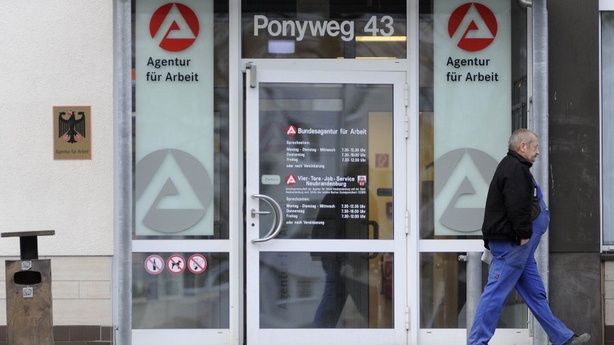[ad_1]
The German economy stagnated in the first quarter, as a decline in government and household consumption was balanced out by an increase in exports and capital investment, data showed today.
Gross domestic product was unchanged quarter on quarter in adjusted terms, the federal statistics office said. A Reuters poll of analysts had forecast growth of 0.2%.
Detailed results for the first quarter will be released by the statistics office on May 25.
“The German economy remained stuck in the mud at the start of 2023, only barely avoiding recession,” Pantheon Macroeconomics’ chief eurozone economist Claus Vistesen said.
The German economy shrank by a revised 0.5% in the fourth quarter of 2022 compared with the previous three months, reviving fears of a technical recession, defined as two consecutive quarters of contraction.
“With the outturn for the fourth quarter also revised down, that left the economy broadly in line with its pre-pandemic level, while GDP is significantly above that mark in Italy and France,” Capital Economics’ senior Europe economist Franziska Palmas said.
The German government raised its economic growth forecast for this year to 0.4% from a previously predicted 0.2%, according to its spring economic projections published earlier this week.
“A gradual recovery is underway, despite a persistently difficult environment,” German Economy Minister Robert Habeck said in the presentation of the forecasts.
He expects an acceleration in growth after the first quarter.
But economists warn that the euro zone’s largest economy has not escaped the risk of a recession yet.
“The recent renaissance in industrial production could very well carry the economy through the second quarter,” ING’s global head of macro Carsten Brzeski said.
“However, we are afraid that looking into the second half of the year, the German economy will continue its flirtation with recession,” he added.
In the second half of the year, the industrial backlog will have been reduced without new strong demand coming in, the impact of the most aggressive monetary policy tightening in decades will fully unfold and a slowdown of the US economy will hit German exports, Brzeski said.
“A technical recession in the winter half-year is off the table for the time being. However, we advise caution regarding the second half of the year,” Commerzbank senior economist Joerg Kraemer said.
Kraemer is worried about the European Central Bank’s sharp rise in interest rates. “In the past, such rate hikes have always been followed by recessions in Germany,” Kraemer said.
German unemployment rises more than expected in April
Meanwhile, German unemployment rose more than expected in April, Labour Office figures showed today, as a sluggish economy took its toll on the labour market.
The Federal Labour Office said the number of people out of work increased by 24,000 in seasonally adjusted terms to 2.567 million. Analysts polled by Reuters had expected that figure to rise by 10,000.
The seasonally-adjusted jobless rate remained stable at 5.6%.

“The spring revival on the labour market remains weak in April,” said Labour Office head Andrea Nahles. “Overall, however, the labour market is in a stable condition.”
Compared to the same month last year, unemployment was up by about 280,000 people, primarily due to the arrival of Ukrainian refugees, Labour Minister Hubertus Heil said
“Nevertheless, we have a stable labour market in a difficult economic environment,” the Minister added.
The unemployment rate will soon tick higher, judging by the rising trend in unemployment claims, according to Claus Vistesen, chief euro zone economist at Pantheon Macroeconomics.
“The increase in April marks a continuation of a rising trend in jobless claims since the beginning of the year, consistent with the sharp slowdown in GDP growth towards the end of last year,” Vistesen said.
In April, there were 773,000 job openings, 79,000 fewer than a year ago.
Although the Federal Labour Office has seen a slowdown in labour demand since the summer of 2022, it remains at a high level.
Germany’s labour market is so tight that workers have gained bargaining power in their wage negotiations.
German public sector workers agreed a generous wage deal with employers on Saturday, that could set a benchmark for other wage deals taking place this year.
“Although this is good news for consumers, it makes things more difficult for the European Central Bank,” said Carsten Brzeski, chief economist at ING.
“Inflation is thus increasingly becoming a demand-driven problem and will remain stubbornly high,” he said.
According to the spring economic projections of the German government, employment is expected to continue to grow this year and next, albeit at a somewhat slower pace.
The government expects an unemployment rate of 5.4% in 2023 and 5.2% in 2024, following 5.3% unemployment in 2022.
[ad_2]
Source link
